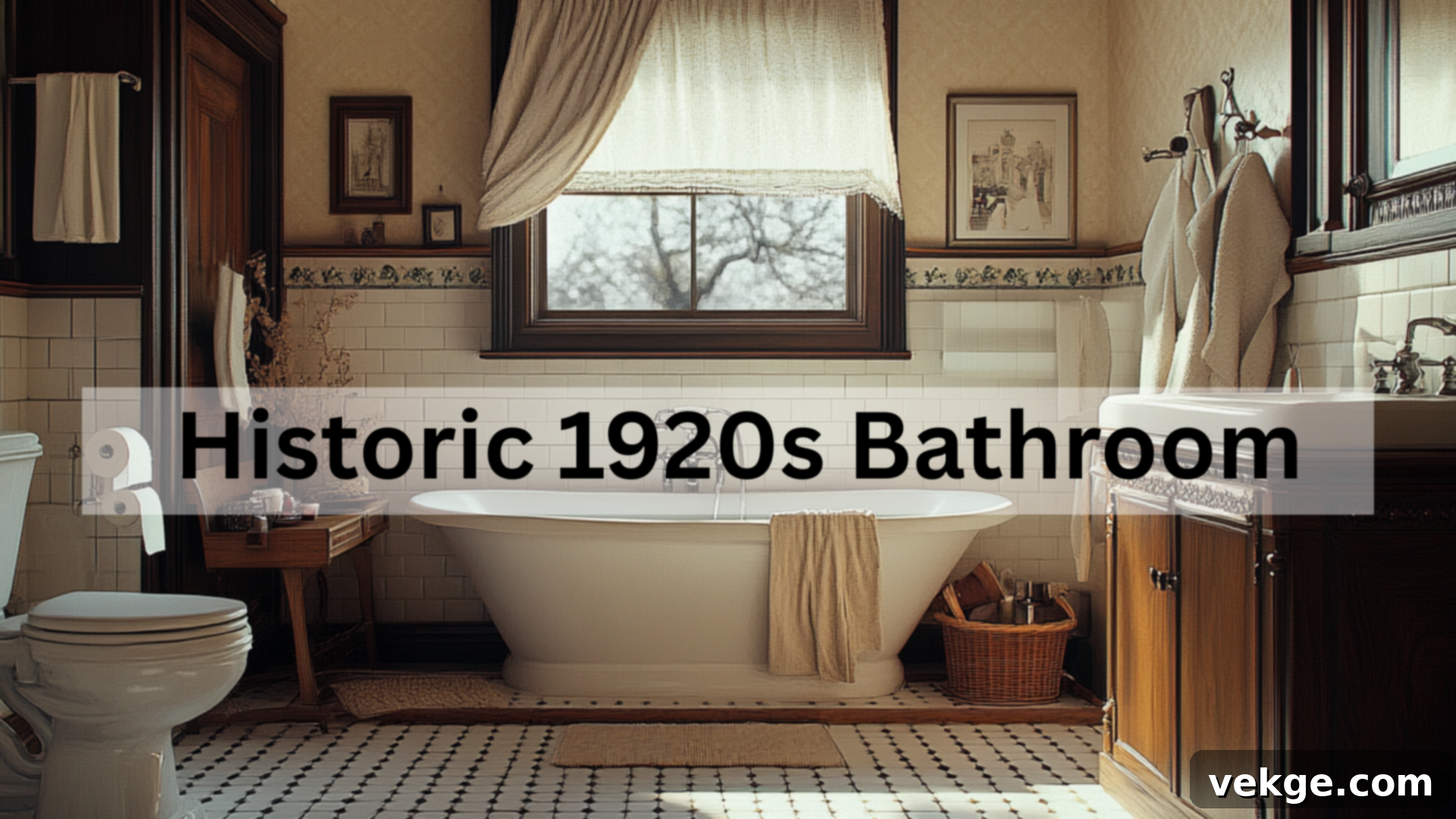Transform Your Bathroom: A Complete Guide to 1920s Vintage Design
Thinking about giving your bathroom a classic, timeless feel? A historic 1920s bathroom is the perfect way to mix vintage charm with everyday comfort and create a truly unique space. This distinctive era, often celebrated for its elegant simplicity and the burgeoning Art Deco movement, offers a wealth of inspiration for homeowners seeking character and sophistication.
Perhaps you’re captivated by the iconic black and white checkerboard tiles, the serene presence of a clawfoot tub, or the bold geometric touches of Art Deco, but aren’t quite sure how to pull all these elements together cohesively. This guide is your ultimate resource, designed to show you everything you need to know to achieve the authentic 1920s look you desire.
Inside, you’ll discover invaluable tips for saving money without compromising on style, easy-to-implement design ideas, smart ways to blend modern updates seamlessly, and practical advice on how to maintain your beautiful vintage-inspired bathroom, ensuring it looks fantastic for years to come. Whether you’re planning a full-scale renovation or just want to infuse a few period-appropriate touches, this comprehensive guide has you covered.
Ready to bring a piece of the past into your home and create a bathroom that stands the test of time? Let’s delve into how you can make your dream 1920s bathroom a stunning reality!
A Brief History of 1920s Bathroom Design
The 1920s marked a pivotal era in home design, particularly for bathrooms. As indoor plumbing became increasingly common and accessible in American homes, bathrooms began their transformation from purely functional, utilitarian spaces into rooms that reflected personal style, comfort, and a new emphasis on hygiene. This decade saw a fascinating evolution in design sensibilities, moving from handcrafted aesthetics to bold modernism.
Early 1920s – The Influence of the Arts and Crafts Movement
Early 1920s bathrooms were heavily shaped by the tail end of the Arts and Crafts movement, which championed handcrafted quality, natural materials, and an appreciation for traditional craftsmanship over mass production. The emphasis was on simplicity, durability, and a clean, fresh aesthetic.
- Subway tiles, typically in glossy white or soft pastels like mint green or pale blue, often with contrasting black accent tiles or trim, covered the walls from wainscot height up to the ceiling. This created a highly sanitary and easy-to-clean surface, a strong selling point after the 1918 influenza pandemic.
- For flooring, white hexagonal tiles were overwhelmingly popular, frequently accented with simple black borders or a scattering of black dot tiles, creating a subtle yet classic pattern. This robust tile choice was both practical and aesthetically pleasing.
- Fixtures like pedestal sinks and elegant claw-foot tubs were predominantly made of durable cast iron with a pristine porcelain enamel coating. Hardware, including faucets and drains, typically featured polished nickel or chrome finishes, chosen for their shine and resistance to tarnish.
- The dominant color schemes leaned heavily toward soft whites, creams, muted greens, and gentle blues. These palettes were selected to evoke a sense of cleanliness, purity, and tranquility, reinforcing the bathroom’s role as a hygienic sanctuary.
Late 1920s – The Rise of Art Deco
By the latter half of the 1920s, a new and exciting aesthetic emerged: Art Deco. This movement introduced a dramatic shift, embracing bold geometry, sleek lines, and a sense of glamorous modernity that captured the spirit of the Jazz Age. Bathrooms began to reflect this more sophisticated and flamboyant style.
- Black-and-white checkered floors became highly popular, offering a more dramatic and graphic contrast than the earlier hexagonal patterns. Zigzag patterns and other geometric motifs also began to appear, adding dynamic visual interest.
- Tiles themselves became more decorative, featuring intricate borders, geometric patterns, and insets that added a sophisticated flair. These patterns often drew inspiration from ancient cultures, industrial machinery, and abstract art.
- Luxury materials like polished marble, frosted or clear glass, and mirrored surfaces were incorporated to add opulence and a sense of spaciousness. These materials reflected light beautifully, enhancing the bathroom’s elegant atmosphere.
- In more upscale and modern homes, the iconic claw-foot tubs began to be replaced by built-in tubs, often recessed into an alcove or surrounded by tiled panels, offering a sleeker, more integrated look.
- The color palettes expanded significantly. While black and white remained prominent, bolder hues like jade green, deep burgundy, sapphire blue, and even touches of gold or silver were introduced as striking accents, moving beyond the purely sanitary aesthetic.
The Transition to More Functional Bathrooms
Throughout the decade, regardless of the evolving aesthetic trends, bathrooms steadily became more functional and efficient without sacrificing their burgeoning style. This period saw many innovations that we now consider standard.
- Built-in cabinets and medicine chests became common, addressing the growing need for storage space for toiletries and linens, keeping the bathroom tidy and organized.
- The introduction of shower attachments, often integrated with the bathtub faucet, greatly improved convenience and flexibility, making daily routines more efficient.
- Wall-hung sinks and toilets gained traction, particularly for their practicality, as they made the floor much easier to clean, further promoting the ideal of a hygienic home.
- A strong cultural emphasis on hygiene meant that smooth, easy-to-clean surfaces became the standard. This influenced everything from tile choices to fixture materials, ensuring that bathrooms were not only beautiful but also meticulously clean.
By the end of the 1920s, bathroom design had successfully achieved a harmonious balance between aesthetic beauty, personal style, and essential everyday practicality, laying the groundwork for modern bathroom concepts.
Key Features of a 1920s Bathroom: Crafting Authentic Style
The 1920s bathroom possesses a distinctive and enduring look, a combination of thoughtful design choices and practical innovations that create a cohesive style still highly admired today. Understanding these key features is essential for authentically recreating the vintage charm.
1. Popular Tile Choices: The Foundation of 1920s Aesthetics
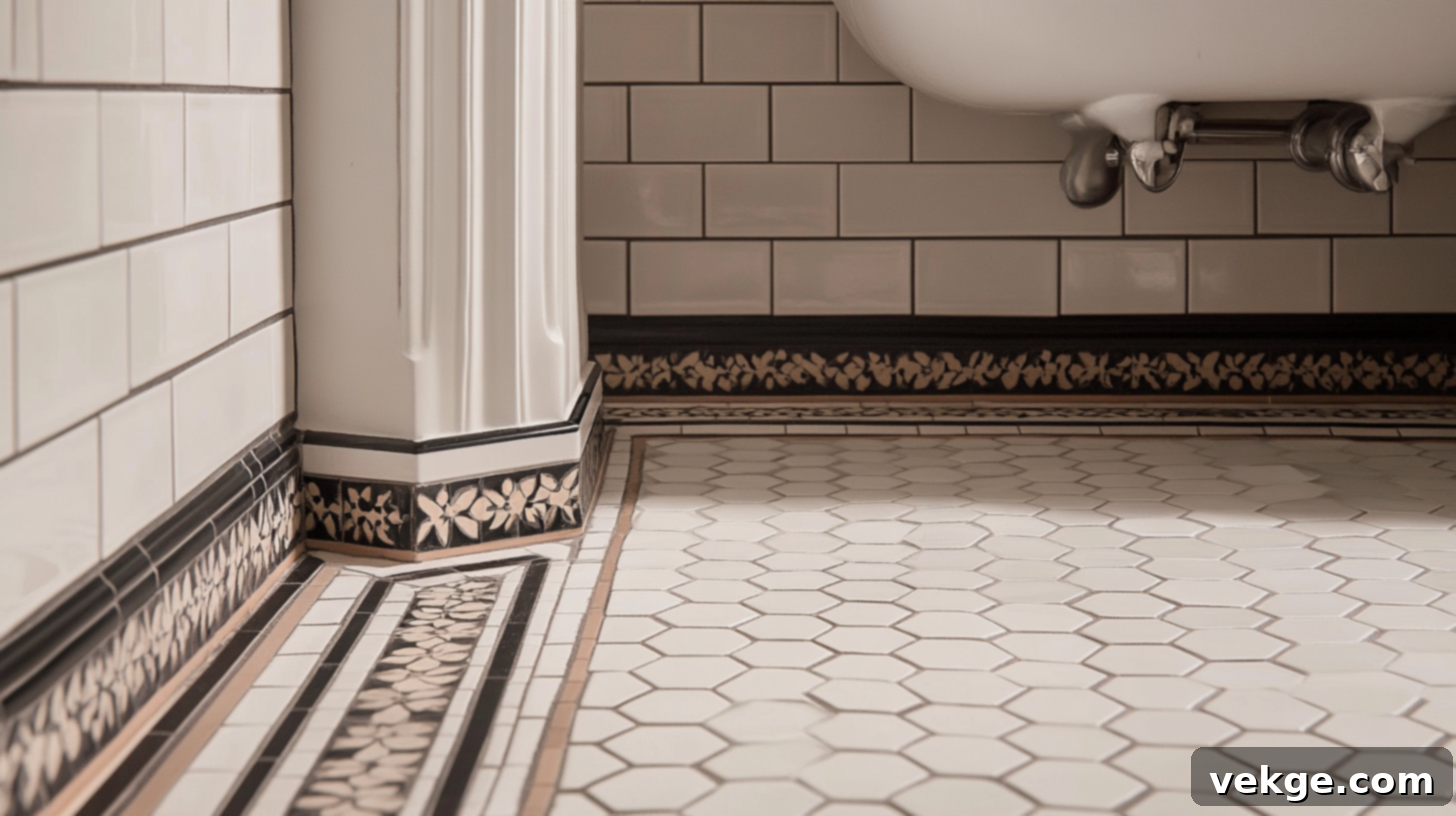
Tile was undeniably the defining material of 1920s bathrooms, chosen for its exceptional durability, ease of cleaning, and significant visual appeal. Glossy subway tiles, typically 3×6 inches, were ubiquitous, covering walls from floor to ceiling or to a wainscot height, creating an exceptionally clean, bright, and sanitary look. This emphasis on hygiene was a direct response to public health concerns following the 1918 influenza pandemic, making tiles a practical and fashionable choice.
These classic tiles were often installed with dark or contrasting grout lines (such as black or gray) to highlight their precise brick-like pattern, adding definition and a subtle graphic quality. For flooring, hexagonal tiles were the dominant choice. White hex tiles with contrasting black dot accents at the intersections or elegant black borders created a timeless and intricate yet understated look. In more affluent or avant-garde homes, more complex patterns like basket weave, combining small rectangular tiles, also began to make an appearance, adding a touch of bespoke luxury to the floor plan.
2. Fixtures and Fittings: Functionality Meets Form
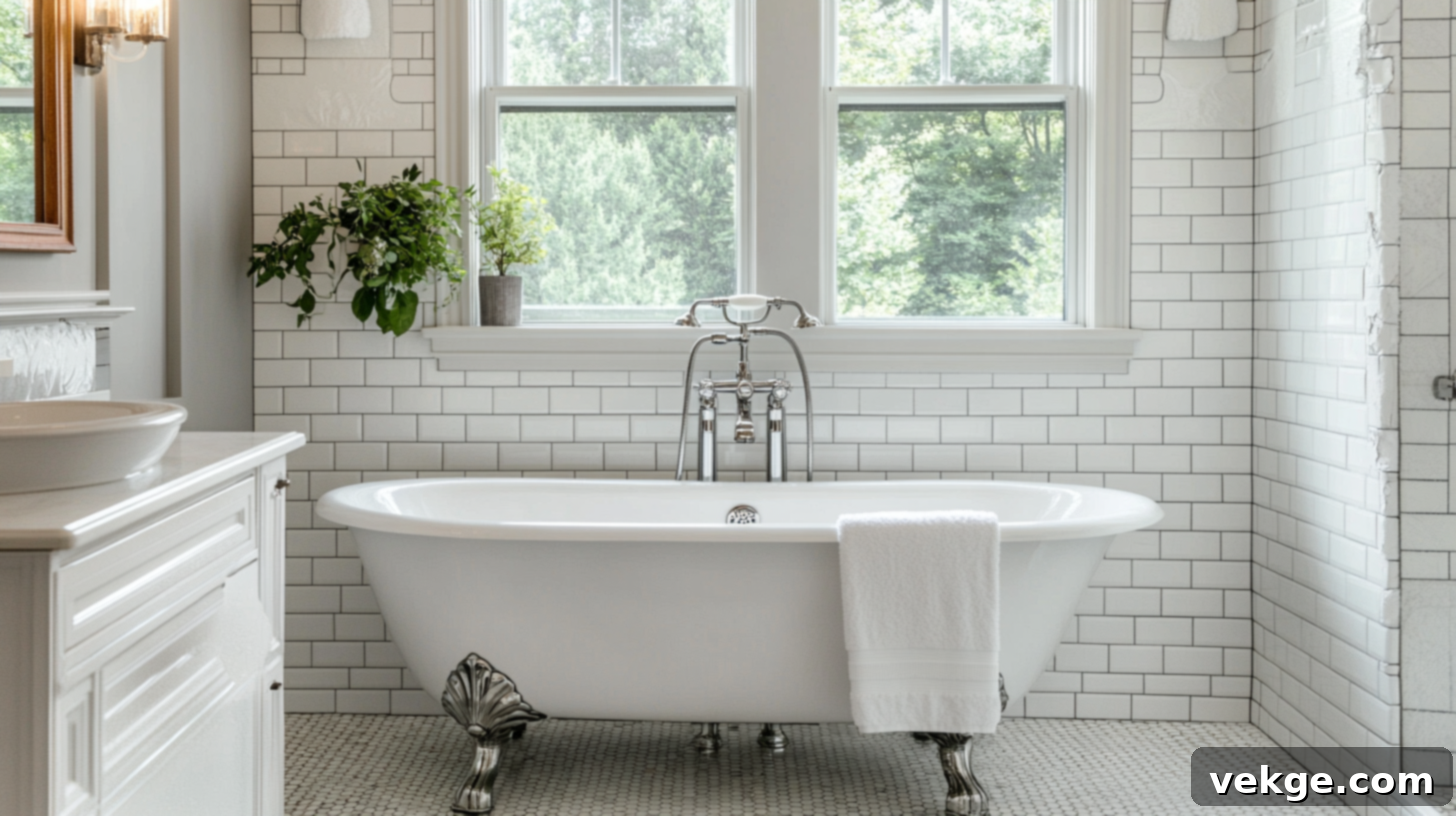
The 1920s bathroom centered around substantial, well-crafted fixtures that communicated permanence, quality, and a sense of refined utility. The bathtub was often the centerpiece. Freestanding cast iron tubs, coated in pristine porcelain enamel, were iconic. These came either with the classic, elegant claw feet that lifted the tub off the floor, or with more modern, streamlined flat bases that offered a slightly more contemporary profile.
Pedestal sinks were another hallmark, featuring wide, deep basins supported by a substantial, often sculptural, pedestal. These offered practical washing space while maintaining an elegant and open profile, contrasting with the heavier cabinet-style vanities of later decades. Faucets and hardware throughout the bathroom typically showcased highly polished nickel or chrome finishes, prized for their bright, clean appearance and durability. Cross handles, rather than single-lever designs, were the standard, adding to the period authenticity.
Completing the look were essential wall-mounted accessories such as matching porcelain or ceramic soap dishes, toothbrush holders, and towel bars, all in finishes that harmonized with the main fixtures. These details were not just functional but also contributed significantly to the cohesive and organized aesthetic.
3. The Importance of Color Schemes: From Sanitary to Sophisticated
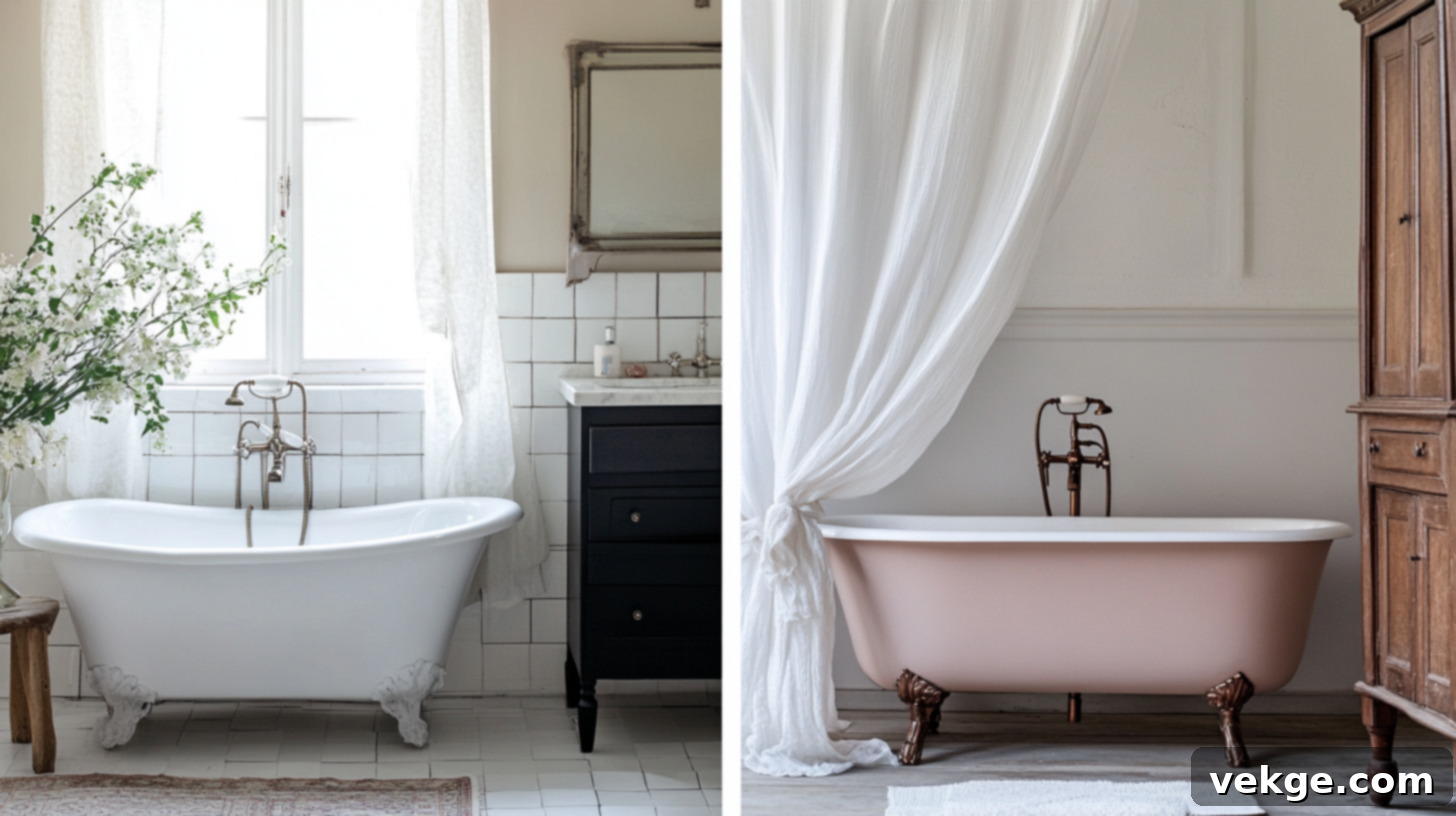
Color played a crucial role in defining the mood and style of 1920s bathrooms. Early in the decade, the prevailing aesthetic favored clean, clinical whites and creams, often accented with strong black contrasts. This palette was deeply rooted in the era’s focus on hygiene and purity, making the bathroom feel bright, spacious, and impeccably clean. The starkness of black against white created a crisp, timeless foundation.
As the decade progressed and the influence of Art Deco grew stronger, color schemes became more adventurous and expressive. While the classic black and white remained popular, the introduction of soft pastels such as mint green, pale pink, and light blue offered a gentler, more decorative touch. These colors were often used for colored fixtures or wall tiles, providing a subtle deviation from pure white. Later Art Deco designs embraced bolder, more saturated hues like jade green, deep burgundy, navy blue, and even gold or silver accents. These richer colors were used sparingly but effectively, perhaps in decorative tile borders, painted walls above tile lines, or in accessory choices, creating a sense of luxury and dramatic flair that perfectly encapsulated the opulent spirit of the late 1920s.
4. Vintage Lighting: Illuminating Style and Function
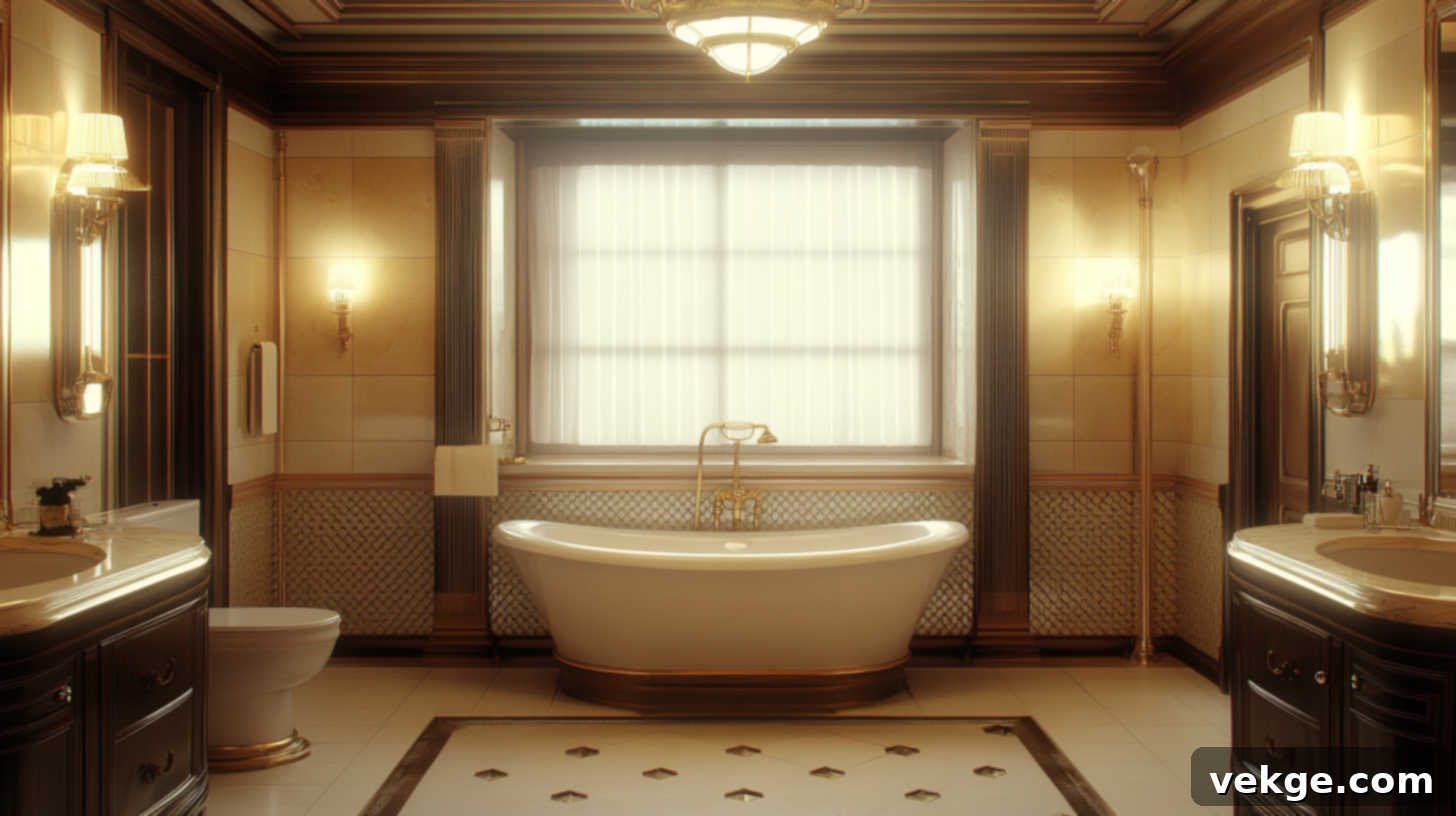
Lighting in 1920s bathrooms was carefully designed to balance essential functionality with period-appropriate style. Early in the decade, the focus was on practical illumination, with simple wall sconces, often featuring frosted or opal glass shades, strategically placed to flank the medicine cabinet or mirror. These provided even, glare-free light for grooming tasks.
As the Art Deco movement gained momentum, lighting fixtures evolved to reflect its distinctive geometric and streamlined aesthetic. More elaborate sconces with angular shapes, layered glass, and polished chrome or nickel finishes became popular. Ceiling fixtures typically consisted of semi-flush or flush-mount glass bowls that diffused light softly and evenly throughout the space, minimizing harsh shadows. For larger bathrooms or those with higher ceilings, pendant lights featuring decorative glass shades or geometric metalwork added a touch of elegance and visual interest, often serving as a central design element. The choice of glass (frosted, etched, or colored) also contributed to the overall ambiance, ensuring the lighting was both effective and aesthetically integrated.
Modern Features That Complement a 1920s Bathroom
When undertaking a bathroom renovation in a 1920s style, the true art lies in balancing historical accuracy with modern functionality. The goal is to create a space that not only looks authentically period-appropriate but also performs to contemporary standards of comfort, efficiency, and convenience. With careful planning and thoughtful selection, you can achieve a harmonious blend, crafting a bathroom that honors the elegance of the past while meeting today’s expectations for a truly comfortable and efficient living space.
Incorporating Modern Efficiency and Comfort Seamlessly
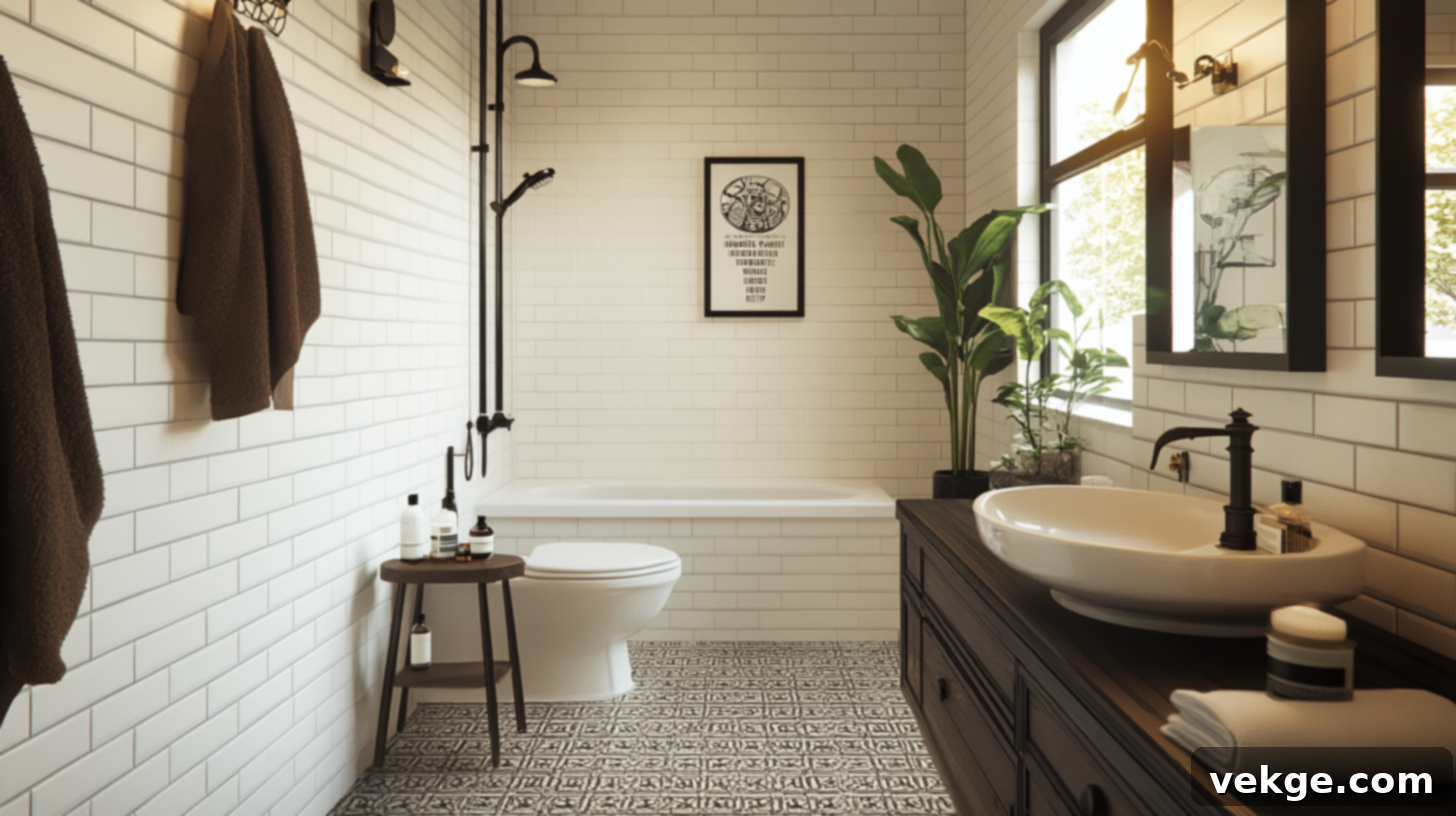
Modern bathroom technology can be seamlessly integrated into a 1920s-inspired space without disrupting its vintage charm. For instance, selecting water-efficient toilets that boast traditional styling – often featuring a higher tank or a classic rounded bowl – allows for significant resource conservation while perfectly maintaining the period aesthetic. In the shower, thermostatic valves can be cleverly installed behind vintage-appearing shower controls, providing consistent and safe water temperature without revealing their modern engineering.
For ultimate comfort, consider invisible upgrades like under-tile radiant heating systems. These add luxurious warmth to the floor on chilly mornings without compromising the visual style of your chosen hexagonal or subway tiles. Effective ventilation is also key; ceiling-mounted exhaust fans, especially those with period-appropriate grilles or covers, efficiently prevent moisture issues, protecting your bathroom from mildew while blending into the classic ceiling design. Furthermore, traditional light fixtures can be retrofitted with warm-toned LED bulbs, significantly reducing energy consumption and offering a long lifespan, all while emitting a historically accurate glow. The most successful renovations are those where modern functionality is expertly hidden behind an impeccably accurate historical appearance.
Smart Bathroom Features with Vintage Style

Smart technology can elevate the convenience and luxury of a 1920s bathroom, provided it is implemented with discretion and thoughtful design. For example, programmable thermostats for floor heating can be discreetly mounted on a wall or integrated into a smart home system, allowing for precise control without visible modern interfaces. Similarly, digital controls for shower systems can be concealed behind traditional-looking faucet handles, offering a consistent temperature and flow with the touch of a button.
Motion-activated vintage-style lighting, where the sensor is hidden, can reduce energy use and add a touch of automated convenience. Concealed water leak sensors provide crucial protection, alerting you via smartphone to any potential plumbing issues before they become major problems. For entertainment or daily routines, hidden speakers can be flush-mounted into the ceiling or walls, delivering high-quality audio without visual intrusion. Furthermore, pop-up electrical outlets or charging ports can be installed inside medicine cabinets or drawers, allowing for modern conveniences like electric toothbrushes and shavers to be charged without visible contemporary elements. The key to successful integration lies in making the technology either invisible or choosing components with finishes, such as polished nickel or chrome, that perfectly complement and enhance the vintage style.
Vintage Mirrors and Decorative Elements: Reflecting Period Charm

Mirrors were central focal points in 1920s bathrooms, often serving as both functional necessities and decorative accents. Typically, these were rectangular mirrors, sometimes with subtly beveled edges, framed in simple painted wood, polished nickel, or gleaming chrome. Look for mirrors with minimal yet elegant framing, or those that subtly incorporate Art Deco influences like stepped details or geometric motifs. A classic medicine cabinet with a mirrored door is also an authentic and practical choice.
Beyond the main mirror, incorporating other glass and ceramic elements can significantly enhance the period feel. Glass shelves supported by sturdy chrome or nickel brackets, along with wall-mounted porcelain or glass soap dishes and toothbrush holders, add both authenticity and utility. For decorative accents, consider displaying reproduction prescription bottles, vintage powder boxes, or elegant ceramic jars on open shelving or the back of the toilet. Framed 1920s magazine advertisements or botanical prints can also add a charming, era-appropriate touch to the walls, bringing personality and historical context to the space.
Towels, Rugs, and Storage: Functional Beauty
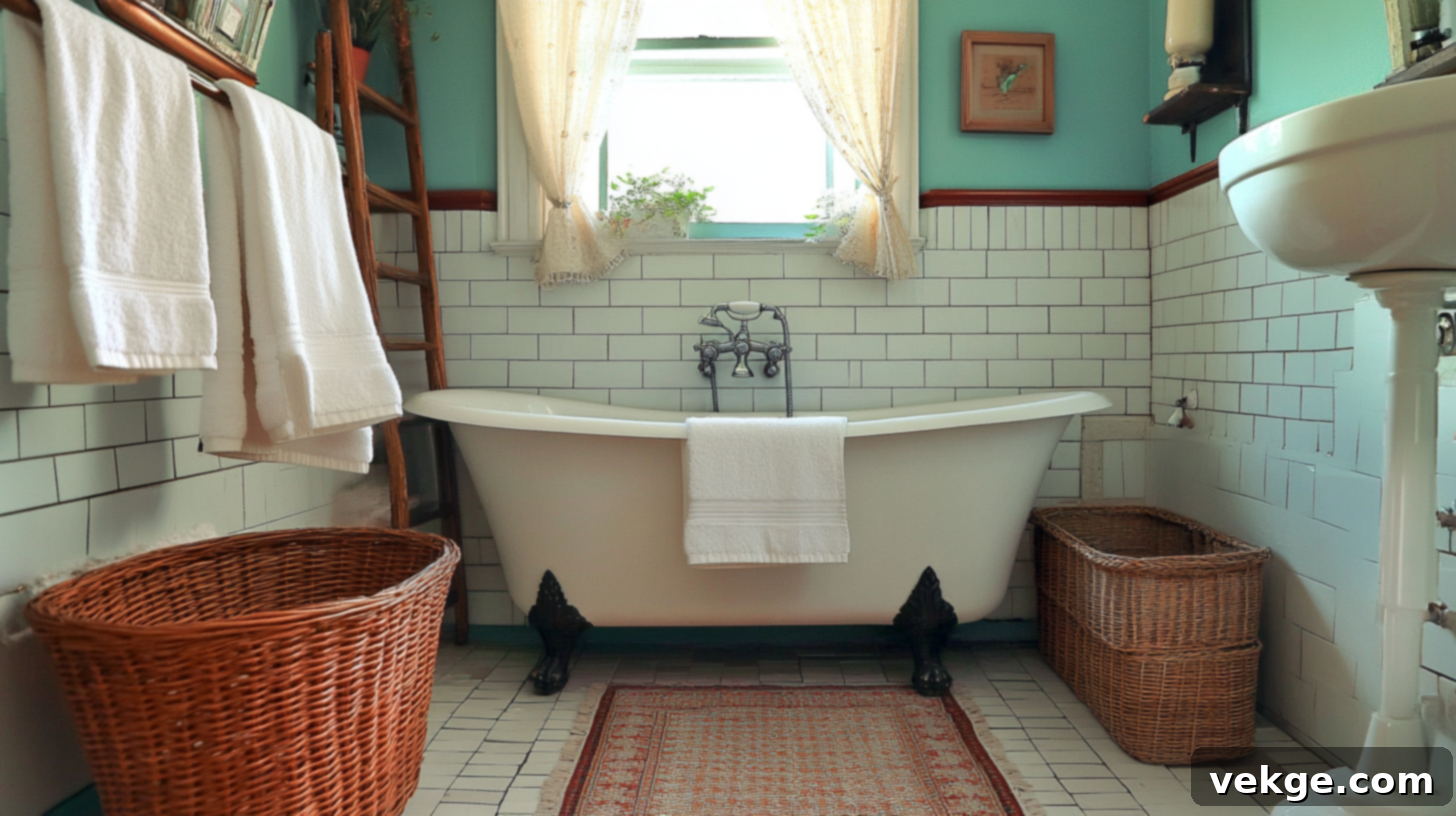
To truly complete the 1920s bathroom aesthetic, pay attention to the softer furnishings and storage solutions. Opt for crisp white cotton towels, perhaps with a simple border in a color that matches an accent shade used elsewhere in the bathroom (like mint green or black), to maintain an authentic and clean appearance. Avoid overly plush or brightly patterned modern towels.
For floor coverings, small cotton rugs in classic geometric patterns or solid colors with subtle borders work exceptionally well. Think simple stripes, small checks, or a restrained Art Deco motif. Avoid shaggy or highly textured rugs that would look out of place. When it comes to storage, keep it understated and integrated. Incorporate wall-mounted glass shelves with chrome brackets for displaying essentials, small painted cabinets (perhaps recessed), or charming wicker baskets for discreetly tucking away towels or supplies. Chrome towel racks and simple wall hooks are practical and align perfectly with the period style. The key is to avoid oversized, bulky contemporary storage pieces that would overwhelm the delicate vintage aesthetic, focusing instead on solutions that are both functional and visually light.
Budget-Friendly Ways to Achieve the Look: Vintage Charm Without Breaking the Bank
You don’t necessarily need a huge budget to create a stunning and authentic 1920s-style bathroom. With a few smart choices, creative sourcing, and a bit of DIY spirit, you can infuse your space with vintage charm without draining your wallet. It’s all about prioritizing key elements and making clever substitutions.
Cost-Saving Tips for Your 1920s Bathroom Renovation
Here are some easy and effective ways to save money while achieving that coveted period look:
- Use reproduction tiles. While original vintage tiles are beautiful, they can be costly and difficult to source in sufficient quantities. Many modern manufacturers produce high-quality reproduction tiles that perfectly mimic 1920s designs—think classic white subway tiles, hexagonal floor tiles with black dots, or basket weave patterns—at a significantly lower cost than authentic vintage options. They often come with the added benefit of modern durability.
- Refinish instead of replacing. If you’re lucky enough to have an existing old cast-iron tub or porcelain sink, or if you find a vintage piece in a salvage yard, consider refinishing it. Professional reglazing or re-enameling services can restore these pieces to their former glory, making them look brand new for a fraction of the cost of buying a new, period-appropriate fixture. This is an excellent way to preserve historical elements and save money.
- Shop secondhand and salvage yards. Treasure hunting is a crucial part of budget-friendly vintage design! Explore architectural salvage yards, local thrift stores, antique shops, and online marketplaces (like eBay or Facebook Marketplace) for genuine vintage fixtures, hardware, mirrors, and accessories. You can often find a clawfoot tub, a pedestal sink, or unique light fixtures at a fraction of the cost of new reproductions. Just be prepared to do some cleaning or minor repairs.
- Focus on key details. Sometimes, it’s the small touches that make the biggest impact. If a full renovation isn’t feasible, invest in just a few high-impact vintage-style elements. Swapping out modern faucets for vintage-inspired polished nickel or chrome models, adding authentic-looking towel bars, or installing a period-style light fixture can dramatically alter the room’s feel without requiring a complete overhaul.
- DIY whenever possible. Empower yourself by tackling certain tasks. Painting walls, installing simple tile patterns (like subway tile), replacing hardware, and even some minor repairs can often be done yourself with the right tutorials and tools. This significantly reduces labor costs, which can be a large portion of any renovation budget. Just be sure to research thoroughly and know your limits!
By strategically applying these tips, you can create a beautiful and authentic vintage-style bathroom that looks far more expensive than it actually was, allowing you to enjoy a piece of the past without overspending.
High-Impact Vintage Touches on a Small Budget
Even if a full renovation is out of reach, incorporating just one or two carefully chosen vintage-style elements can completely transform the atmosphere of your bathroom, imbuing it with significant character and period charm. Here are some easy ideas for big impact with a small budget:
- Install a pedestal sink. This single fixture is perhaps the quickest and most effective way to evoke a 1920s feel. Pedestal sinks are often budget-friendly, relatively easy to install, and immediately convey classic elegance, replacing bulky modern vanities with a lighter, more open design.
- Add black and white floor tiles. If your current flooring is plain, a small investment in classic black and white tiles can make a monumental difference. Patterns like white hexagons with black dots or a simple basketweave instantly set the mood and are a quintessential 1920s design element. This can be done in a small area or as a full floor update.
- Swap out hardware. Replace modern, generic knobs and pulls on existing cabinetry or doors with antique or vintage-inspired ones. Look for finishes like polished nickel, chrome, or even glass knobs. This subtle change is surprisingly effective in enhancing the period authenticity.
- Hang vintage-style mirrors. A simple rectangular mirror with a decorative frame—perhaps in a chrome finish, or a painted wood frame with a subtle Art Deco detail—can anchor the room’s style. Look for options with beveled edges for an extra touch of vintage sophistication. This is a quick and impactful visual upgrade.
- Use vintage light fixtures. Lighting is crucial for setting ambiance. Search for wall sconces that flank your mirror or an overhead light with a distinct 1920s flair. Frosted glass shades, geometric metalwork, and chrome or nickel finishes are key. Even a single well-chosen fixture can significantly contribute to the vintage aesthetic.
Remember, sometimes less is more. Even just one or two of these targeted changes can bring a remarkable amount of character, authenticity, and historical appeal to your space, making it feel truly special and thoughtfully designed.
Maintenance and Care for a Vintage-Style Bathroom
Once your beautiful vintage-style bathroom is complete, the journey doesn’t end there. To ensure it retains its charm and elegance for many years to come, it’s crucial to implement a routine of regular maintenance and careful cleaning. Proper care goes a long way in preserving the integrity and aesthetic appeal of your period-inspired space.
How to Care for Vintage Tile and Fixtures: Preserving Their Beauty
Old or vintage-style materials, especially those that mimic the delicate finishes of the 1920s, often require a little extra attention and the right cleaning products. Here’s how to keep them in top shape and looking pristine:
- Clean tiles gently. For porcelain or ceramic tiles, always use mild, pH-neutral soap and warm water. Avoid harsh, abrasive cleaners, acidic solutions (like vinegar on natural stone or grout), or strong bleach-based products, as these can dull the tile’s finish, erode grout, or damage the glaze over time. A soft cloth or sponge is usually sufficient for daily cleaning.
- Seal grout lines regularly. Grout is porous and can easily absorb stains and moisture, leading to discoloration and deterioration. Protect your grout from grime and water damage by applying a high-quality grout sealant every one to two years, or as recommended by the product manufacturer. This creates a protective barrier, making cleaning easier and extending the life of your grout.
- Polish metal fixtures appropriately. The polished nickel and chrome finishes common in 1920s bathrooms can tarnish or spot if not cared for correctly. Clean these metals with products specifically designed for that particular type of metal. For chrome, a damp cloth and mild soap usually suffice. For nickel, a non-abrasive metal polish can help maintain its luster. Always dry fixtures thoroughly after cleaning to prevent water spots and mineral buildup.
- Check for leaks proactively. Vintage plumbing fixtures, even reproductions, can be more prone to leaks than modern counterparts due to their design or materials. Regularly inspect under sinks, around the base of toilets, and near tub fittings for any signs of drips or moisture. Fixing small leaks early prevents bigger problems like water damage to floors or walls, which can be costly and destructive.
- Avoid abrasive tools and materials. When cleaning any part of your vintage-style bathroom, always use soft cloths, microfiber towels, and non-scratch sponges. Steer clear of scouring pads, steel wool, or stiff brushes, as these can easily scratch and permanently damage the delicate surfaces of vintage tiles, porcelain enamel, and metal finishes.
A little consistent, gentle care will ensure your vintage-style bathroom remains fresh, sparkling, and true to its elegant 1920s spirit for decades to come, providing enduring beauty and functionality.
Common Issues to Watch For: Preventing Deterioration
While beautifully designed, vintage and vintage-style bathrooms can develop a few common problems if not regularly inspected and maintained. Being aware of these potential issues allows for early detection and quicker, easier repairs.
Here’s what to watch out for to keep your bathroom in top condition:
- Tile cracking or loosening: This can occur due to moisture penetration, movement in the subfloor, or simply age and wear. Pay attention to any hairline cracks or tiles that feel loose when stepped on or touched.
- Metal corrosion: Faucets, handles, and pipes made of brass, nickel, or chrome can corrode or tarnish over time, especially in areas with high humidity or hard water. Look for green or reddish discoloration, pitting, or dullness.
- Grout discoloration or deterioration: Even with sealing, grout can become discolored from mildew, dirt, or water exposure. It can also crack or crumble, leaving gaps where moisture can seep in.
- Wear and tear on painted surfaces and cabinetry: Moisture and humidity can cause paint to chip, peel, or blister on walls, trim, or any wooden cabinetry. Keep an eye out for swelling or warping.
- Plumbing leaks or drips: Old pipes, seals, or fixture components can degrade, leading to slow leaks or persistent drips from faucets, showerheads, or the toilet. These can cause significant water damage if ignored.
Catching these problems early makes repairs much easier, less expensive, and helps prevent further damage, ensuring your charming 1920s bathroom looks as impeccable and inviting as the day you finished its beautiful transformation.
Conclusion: Embrace the Enduring Elegance of a 1920s Bathroom
Bringing the historic elegance of a 1920s bathroom to life is a rewarding endeavor that masterfully blends classic style with smart, modern updates. You now have a comprehensive understanding of how to achieve this distinctive look, how to implement clever strategies to save money during your renovation, and most importantly, how to care for and maintain everything to ensure it stays in magnificent shape for years to come.
Whether you’re contemplating starting small with a few vintage-inspired accessories or planning a complete, transformative makeover, you are now equipped with a wealth of ideas and practical tips to make your vision a reality. Remember, even the most subtle vintage touches—a classic pedestal sink, a carefully chosen light fixture, or simply the timeless appeal of black and white tiles—can make a profound difference in the character and ambiance of your space, elevating it beyond the ordinary.
If you’re eager for more home design inspiration, practical ideas, and helpful tips to create a home that truly reflects your unique style, don’t stop here! We encourage you to explore our other blogs for even more fascinating insights and creative solutions to make every room in your home feel special, charming, and perfectly tailored to your dreams.
Frequently Asked Questions About 1920s Bathroom Design
What are the most important aspects of 1920s bathroom color schemes?
Early 1920s bathrooms were largely dominated by crisp white and bold black, creating a clean and sanitary aesthetic. As the decade progressed, soft pastels like mint green, light blue, and pale pink emerged, often used for colored fixtures or accent tiles. Later, with the rise of Art Deco, bolder accents in colors such as deep black, sophisticated navy, rich burgundy, or even touches of gold provided dramatic contrast against more neutral backgrounds, adding a sense of luxury and glamour.
What kind of lighting is best for a 1920s bathroom?
For an authentic 1920s look, wall sconces with white or frosted glass shades are ideal, typically flanking the medicine cabinet or mirror to provide even illumination for grooming. Ceiling fixtures often featured glass bowls or semi-flush mounts that diffused light softly. As the Art Deco influence grew, fixtures with geometric patterns, layered glass, and highly polished chrome or nickel finishes became popular, adding a sleek, modern touch while retaining period charm.
What type of flooring works best for a 1920s bathroom?
The most authentic flooring choice for a 1920s bathroom is unquestionably hexagonal tiles, particularly in white with small black dot accents at the intersections or a simple black border. Basket weave patterns, which mix small rectangular tiles, also appeared in more upscale homes, offering a slightly more intricate design. Small mosaic tiles arranged in simple, geometric patterns are also a fitting choice, providing durability and a classic visual appeal that stands the test of time.
Are 1920s bathrooms functional for today’s living?
Absolutely! While maintaining the vintage aesthetic, 1920s-inspired bathrooms can be highly functional and comfortable for modern living. The key is to blend period-appropriate fixtures and materials with discreet modern conveniences. Low-flow toilets with traditional styling, thermostatic shower controls hidden behind vintage handles, under-tile radiant heating, and hidden smart technologies can all be seamlessly integrated to create a beautiful, efficient, and comfortable space that meets contemporary demands without sacrificing its timeless charm.
Where can I find authentic or reproduction 1920s bathroom fixtures and decor?
You can find authentic 1920s fixtures, hardware, and decorative elements at architectural salvage yards, antique shops, estate sales, and online marketplaces like eBay or Etsy. For high-quality reproductions, many specialized retailers and bathroom suppliers offer vintage-style tubs, pedestal sinks, toilets, faucets, and tiles designed to perfectly replicate the look of the era. Always check reviews and consider the quality of materials when purchasing reproductions to ensure durability and aesthetic accuracy.
